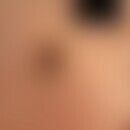Synonym(s)
DefinitionThis section has been translated automatically.
This term covers both primary infections and recurrent infections caused by herpes simplex viruses in the genital area. Several clinical pictures fall under it:
- vulvovaginitis herpetica
- Balanitis (Balanoposthitis) herpetica
- proctitis herpetica
- urethritis herpetica
Occurrence/EpidemiologyThis section has been translated automatically.
In 2016, an estimated 491.5 million people aged 15 to 49 years were infected with HSV-2 (seroprevalence of 13.2%) and 3.75 billion people aged 0 to 49 years were infected with HSV-1 (seroprevalence of 66.6%). Seroprevalence is highest in the African region. In the National Health and Nutrition report from the United States from 2015 to 2016
While HSV-2 was long thought to be directly descended from HSV-1, genome sequencing shows that HSV-2 originated from great ape herpesviruses and was likely transmitted to humans as a zoonotic infection about a million years ago. Both HSV-1 and HSV-2 have sophisticated mechanisms to evade aspects of the host immune system, contributing to their asymptomatic transmission and acquisition. HSV-1 and HSV-2 invade the skin and mucosa through epithelial defects in the epidermis and replicate in the dermis.
You might also be interested in
EtiopathogenesisThis section has been translated automatically.
The majority of infections (80-90%) are due to HSV-2 . Infections with HSV-1 are increasing (Mathew R et al. 2018). The most common clinical manifestations are vulvovaginitis herpetica and balanitis (balanoposthitis) herpetica.
The primary infections of genital herpes are asymptomatic in 2/3 of cases. In a symptomatic course, an acute clinical picture with general symptoms occurs after a short prodromal stage: malaise, fever, moderately painful regional lymphadenitis. At the site of infection, painful grouped vesicles develop on an erythematous base. The blisters burst or become cloudy and purulent. In the skin area, a crust then forms and heals. No crusts develop in the mucous membrane area. Healing takes place via erosive lesions that epithelize without scarring.
Primary vulvovaginitis herpetica is often characterized by dysuria and micturition problems!
Recurrent genital herpes is clinically much milder than the primary infection and often goes unnoticed. Patients with an HSV-2 induced viral infection develop recurrences more frequently than those infected with HSV-1 (5xyearly/1xyearly).
Mild prodromes similar to an intercurrent flu-like infection can occur. Many women do not notice the recurrence at all. The grouped vesicle formation is accompanied by a slight burning pain symptomatology. Lymphadenitis may or may not be present. A high percentage of women with documented recurrent genital herpes simplex have asymptomatic viral shedding.
Complication(s)(associated diseasesThis section has been translated automatically.
Acyclovir resistance is being observed with increasing frequency. HSV resistance is usually caused by deletion of the viral thymidine kinase (Kälber KA et al. (2024).
Co-infection with cytomegaloviruses can occur in HIV-infected persons with HSV-2 infection. Clinically, such dual infections manifest themselves in therapy-resistant (extensive) ulcers in the genital area (Rawre J et al. 2018). Co-infections with molluscipox viruses can cause pseudotumorous structures.
General therapyThis section has been translated automatically.
The acyclic nucleoside analogs acyclovir and its prodrug valacyclovir as well as famciclovir are approved for the treatment of genital herpes simplex. These guanosine nucleoside analogs require initial phosphorylation by the HSV-encoded thymidine kinase, followed by phosphorylation by cellular kinases. This nucleotide triphosphate is then incorporated into the growing DNA chain by HSV DNA polymerase during DNA replication, leading to chain termination. These antiviral agents have excellent safety profiles.
Internal therapyThis section has been translated automatically.
Primary infection:
- In severe cases, systemic therapy with acyclovir (Zovirax 200) 5 times/day 1 tbl. every 5-10 days. Oral therapy is usually sufficient (Milpied B et al. 2019).
- Alternative: Aciclovir 400mg p.o. 3x daily for 7-10 days
- Alternative: If necessary, intravenous therapy with acyclovir can be considered (acyclovir 5 mg/kg bw 3 times/day every 8 hours for 5 days).
- Alternative: Valciclovir: 500-1000mg p.o./2x/day for 5-10 days.
- Famciclovir: 250mg p.o. 3x/day for 5-10 days.
- Patients with immunosuppression: Acyclovir 400mg 4x/day or Zovirax 800mg 5 times/day.
Recurrence:
- Systemic therapy with acyclovir (Zovirax 200) 2 times/day 1 tbl. for 5-10 days. Oral therapy is usually sufficient.
- Alternative: Aciclovir 800mg p.o. 3 times/day for 2 days
- Alternative: Valciclovir: 500mg p.o./2x/day over 3-5 days (Milpied B et al. 2019).
- Famciclovir: 125mg p.o. 2x/day once
Relapse prophylaxis:
- Systemic therapy with acyclovir (Zovirax 400) 2 times/day
- Alternative: Valciclovir: 500mg p.o./1x/day
- Famciclovir: 250mg p.o. 2x/day
- Recurrence prophylaxis is usually carried out over months to years. It is successful in 80% of those affected and recurrences are significantly reduced. Periodic breaks in therapy should be taken to monitor recurrence behavior.
Prophylactic therapy during pregnancy:
- Women with a primary infection or re-infection during pregnancy can be treated prophylactically from the 36th week of pregnancy (weeks' amenorrhea) until the birth:
- Acyclovir: 400mg/day p.o.
- Alternatively: Valciclovir 500mg/day p.o.
Note: A positive effect of suppressive long-term therapy with nucleoside analogs on the risk of the infant developing neonatal herpes has not been proven (Milpied B et al. 2019).
Recommended approach during pregnancy:
Primary infection:
- 3 x 400 mg acyclovir over 10 days
Primary infection 1st + 2nd trimester:
- vulvovaginal swabs (PCR) from 32 weeks' gestation. In case of negative smear without lesions, vaginal delivery.
- In case of positive smear or lesions, caesarean section.
Primary infection > 34th week of pregnancy:
- 3 x 400 mg acyclovir/d until birth, primary caesarean section.
Recurrences:
- The dosage for prophylaxis from the 36th week of pregnancy is 3 x 400 mg acyclovir/d.
- Vulvovaginal swabs around the ET (PCR); if negative: vaginal delivery. If positive or lesions: primary caesarean section.
In case of Acyclovir resistance: a local Cidofovir gel (Natrosol-based 1% - 2x daily) can be used.
Complementary medical therapy methodsThis section has been translated automatically.
Systemic treatment with lysine, an amino acid, 3000 mg/day in acute cases has proven effective. The amino acid lysine in a dose of 3 x 500-1000 mg / day leads to faster relief until the acute herpes simplex heals. Commercial preparation for dietary treatment: Lyranda® chewable tablets. In addition to L-lysine, these also contain zinc, selenium, vitamins and bioflavonoids. Recommended dosage is 3 chewable tablets/day until healing. There are also Lysine 500 and A Vitale L Lysine 750® Tbl.
Additional local therapy with lemon balm leaves (Lomaherpan® cream), initially 4 x / day, then applied 2-4 x daily. Also suitable for prophylaxis and care - here there is a combination of lemon balm leaves with additional sun protection factor 30 (Lomaprotect ®)
Furthermore, tanning drugs, sage leaves in combination with rhubarb root (Rhei radix) (Pyralvex®) are used for brushing. In the study by Saller R. et al, an equivalent effect to acyclovir was shown with fewer dropouts.
Purple coneflower (Echinaceae herba) (Echinacin® Ointment Madaeus) is also used.
Case report(s)This section has been translated automatically.
Case report: 41-year-old woman with HIV who presented with extensive and painful genital ulcers. Histologic examination of a biopsy specimen was suggestive of herpes infection and intravenous acyclovir was started, but only resulted in partial improvement. The biopsy sample was subjected to PCR and both HSV and CMV DNA were detected. Oral administration of valganciclovir was started with therapeutic success. CMV infection is common in HIV-infected patients, but the occurrence of CMV in mucocutaneous lesions is rarely reported. This case illustrates the difficulties in diagnosing genital ulcers in HIV-infected patients. The occurrence of excessive and persistent HSV genital ulcers in HIV patients should also raise suspicion of co-infection with other organisms such as CMV (Jumpertz M et al. 2023).
Case report 2 A 25-year-old man visited the emergency department with a 3-month history of multiple, recurrent and painful genital ulcers. The lesions had started as multiple vesicles on his genitalia and groin area and had ruptured and coalesced into ulcers that gradually progressed and were associated with bleeding. The patient had been diagnosed with HIV 1.5 months prior to presentation and had started antiretroviral treatment (combination of tenofovir, lamivudine and dolutegravir). He had significant weight loss and dysuria for a year.
Physical examination revealed multiple, well-defined, profuse, tender and non-ossified ulcers of irregular shape and size, varying from 10 × 10 mm to 70 × 40 mm, covered with hemorrhagic crusting. They were located in the right groin area, on the glans penis and on the right side of the scrotum and lower abdomen. There was phimosis and the opening of the meatus was covered. There was bilateral firm and tender inguinal lymphadenopathy (Agrawal A et al. 2023).
LiteratureThis section has been translated automatically.
- Agrawal A et al. (2023) Nonhealing exuberant red ulcers on the genitalia in an immunocompromised patient. Clin Exp Dermatol 48:280-283.
- Bauer GR et al. (2010) Herpes simplex virus type 2 seropositivity and relationship status among U.S. adults age 20 to 49: a population-based analysis. BMC Infect Dis 10:359.
- Gouveia AI et al. (2014) Herpes simplex virus and cytomegalovirus co-infection presenting as exuberant genital ulcer in a woman infected with human immunodeficiency virus. Clin Exp Dermatol 39:915-917.
- Harfouche M et al. (2019) Herpes simplex virus type 1 epidemiology in Africa: Systematic review, meta-analyses, and meta-regressions.J Infect pii: S0163 4453.
- Hassan ST et al. (2015) Bioactive natural products with anti-herpes simplex virus properties. J Pharm Pharmacol 67):1325-1336
- Itzhaki RF (2017) Herpes simplex virus type 1 and Alzheimer's disease: possible mechanisms and signposts. FASEB J 31:3216-3226. https://www.ncbi.nlm.nih.gov/pubmed/28765170
- Jumpertz M et al. (2023) Intravenous cidofovir for pseudotumoral genital herpes simplex virus infection in two persons living with human immunodeficiency virus (HIV). Int J Dermatol 62:e212-e213.
- Kälber KA et al.(2024) Aciclovir-resistant HSV-2-induced genital ulcer. JDDG 22: 1006-1008
- Li H et al. (2023) Mpox and herpes simplex virus type 2 coinfection in a patient with HIV. Clin Dermatol 41:655-656.
- Mathew R et al. (2018) Herpes Simplex Virus 1 and 2 in Herpes Genitalis: A Polymerase Chain Reaction-Based Study from Kerala.Indian J Dermatol 63:475-478.
- Milpied B et al. (2019) Diagnostic and therapeutic recommendations for sexually transmitted diseases: Genital herpes.Ann Dermatol Venereol 146:31-36.
- Omarova S et al. (2022) Genital Herpes Simplex Virus-An Updated Review. Adv Pediatr 69:149-162.
- Rawre J et al.(2018) Herpes simplex virus type 2 and cytomegalovirus perigenital ulcer in an HIV infected woman.Indian J Med Microbiol 36:441-443.
- Spicknall ICH et al. (2021) Estimates of the Prevalence and Incidence of Genital Herpes, United States, 2018. Sex Transm Dis 48:260-265.
- Treml J et al. (2020) Natural Products-Derived Chemicals: Breaking Barriers to Novel Anti-HSV Drug Development. Viruses 12:154.
- van de Sand L et al. (2021) Antiviral Active Compounds Derived from Natural Sources against Herpes Simplex Viruses. Viruses 13:1386.
- van de Sand L et al. (2021) Antiviral Active Compounds Derived from Natural Sources against Herpes Simplex Viruses. Viruses 13:1386.
- Van Wagoner N et al. (2023) Genital Herpes Infection: Progress and Problems. Infect Dis Clin North Am 37:351-367.
Outgoing links (6)
Aciclovir; Cytomegalovirus; Famciclovir; Herpes simplex virus; Valaciclovir; Vulvovaginitis herpetica;Disclaimer
Please ask your physician for a reliable diagnosis. This website is only meant as a reference.






